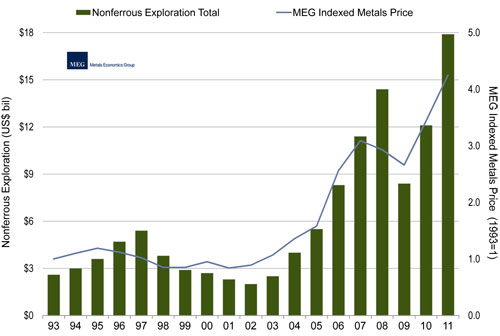According to Metals Economics Group’s (MEG) Corporate Exploration Strategies, the estimated total 2011 budget for nonferrous metals exploration surged to $18.2 billion. Despite increased volatility in recent months, metals prices—the primary driver of exploration spending—have remained relatively strong in 2011, giving confidence to the industry; as a result, exploration budgets increased by $6.1 billion, up 50% from 2010 to set a new all-time high. Nonferrous exploration refers to expenditures related to precious and base metals, diamonds, uranium, and some industrial minerals; it specifically excludes iron ore, aluminum, coal, and oil and gas.

Most countries are seeing increased exploration investment in 2011, and explorers are demonstrating a higher tolerance for risk despite additional concerns and uncertainty about security, policy, and tenure in many countries. Of the 120 countries for which we documented exploration spending by the industry, those commonly perceived to be high risk account for 23% of the 2011 aggregate exploration total, up from less than 16% in 2010. The potential reward often increases the industry’s appetite for risk during periods of increased exploration spending, but exploration in high-risk countries, particularly early-stage work, is usually the first to be cut when risk levels or uncertainty increases.
The proportion of overall exploration spending dedicated to early-stage and generative work has been fairly stable over the past three years; however, at just a third of overall allocations it is historically low. The decline in grassroots’s share of spending over the past decade correlates with the upward trend in late-stage and minesite budgets, as companies spent more on late-stage projects to move them towards production or to make them attractive for acquisition, and on minesite work as a less expensive and less risky means of replacing and adding reserves. However, the number of large-scale assets advancing to development has not risen proportionately with this increased focus on late-stage projects, contributing to constraints on meaningful production increases for most metals. The apparent decline in grassroots efforts relative to late-stage and minesite exploration over the past cycle and the considerable time needed to advance a new discovery to production mean that the pool of viable, large-scale assets available for actual development is unlikely to grow in the near future.
MEG’s 2011 exploration estimate is based on information collected from almost 3,500 mining and exploration companies worldwide, of which more than 2,400 had exploration budgets in 2011. The 2,400 companies (each budgeting at least $100,000) together budgeted $16.3 billion for nonferrous exploration in 2011. Including estimates for the budgets that MEG could not obtain, the 2011 worldwide exploration budget totals $18.2 billion.
From the report entitled, “Exploration budgets up 50% – surging to new all-time high” by Metals Economics Group. Metals Economics Group (MEG) is a trusted source of global mining information and analysis. With three decades of comprehensive information and analysis, MEG has an unsurpassed level of experience and historical data. The information provided herein has been provided to MiningFeeds.com by the author and, as such, is subject to our disclaimer: CLICK HERE.



 Follow us on Twitter
Follow us on Twitter Become our facebook fan
Become our facebook fan










Comments are closed.